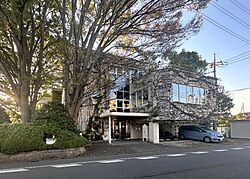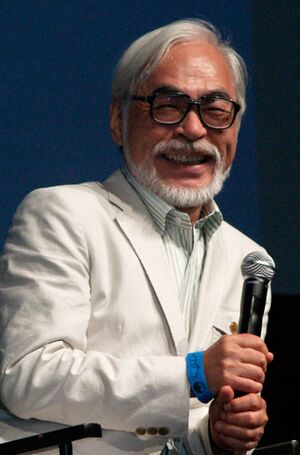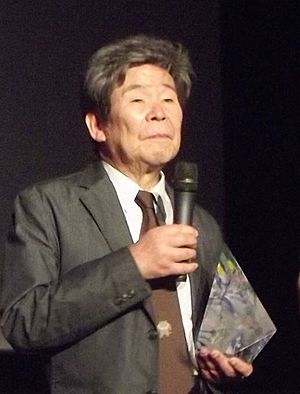Studio Ghibli facts for kids
 |
|

Headquarters in Koganei, Tokyo
|
|
|
Native name
|
株式会社スタジオジブリ
|
|---|---|
|
Romanized name
|
Kabushiki-gaisha Sutajio Jiburi |
| Subsidiary | |
| Industry |
|
| Genre | Anime |
| Predecessor | Topcraft |
| Founded | June 15, 1985, in Tokyo, Japan |
| Founders |
|
| Headquarters | Kajino-chō,
Koganei, Tokyo
,
Japan
|
| Products | Animated feature films, animated short films, television films, commercials, live-action films |
| ¥4.9 billion (2024) | |
| Total assets | ¥38.8 million (2024) |
|
Number of employees
|
190 |
| Parent |
|
| Subsidiaries | Studio Kajino |
Studio Ghibli, Inc. (Japanese: 株式会社スタジオジブリ, Hepburn: Kabushiki-gaisha Sutajio Jiburi) is a famous Japanese animation studio located in Koganei, Tokyo. It was started on June 15, 1985, by amazing directors Hayao Miyazaki and Isao Takahata, along with producer Toshio Suzuki. They formed the studio after getting the assets from another company called Topcraft.
Studio Ghibli is well-known in the animation world. They make many types of animated works, including short films, TV commercials, and TV movies. Their films are loved by critics and audiences and have won many awards. The studio's most famous character is Totoro from the 1988 movie My Neighbor Totoro. Totoro is a giant forest spirit inspired by Japanese raccoon dogs and cats. Some of their most successful films include Princess Mononoke (1997), Spirited Away (2001), Howl's Moving Castle (2004), Ponyo (2008), and The Boy and the Heron (2023).
Studio Ghibli has won many important awards. These include two Academy Awards (Oscars) for Best Animated Feature, a Golden Globe Award for Best Animated Feature Film, and a BAFTA Award for Best Animated Film. They also won a Golden Bear award and several Japanese film awards. Four of their films are among the highest-earning Japanese movies ever. Spirited Away is the third highest-grossing Japanese film, earning over 31.68 billion yen in Japan and more than US$380 million worldwide.
Contents
What's in a Name?
The name "Ghibli" was chosen by Hayao Miyazaki. It comes from an Italian word that means a hot desert wind. Miyazaki picked this name because he loves aircraft. He also wanted the studio to "blow a new wind" through the world of anime. The Italian word is pronounced more like "Giburi," but in Japanese, the studio's name is pronounced "Jiburi."
Studio Ghibli's Journey
How It All Started
Studio Ghibli was founded on June 15, 1985. The main people behind it were directors Hayao Miyazaki and Isao Takahata, and producer Toshio Suzuki. These three had already worked together for many years in Japanese animation. They had made films like The Great Adventure of Horus, Prince of the Sun and the Panda! Go, Panda! movies. Suzuki used to be an editor for a manga magazine called Animage.
The studio was created after the big success of the 1984 film Nausicaä of the Valley of the Wind. Suzuki was part of that film's production. He then teamed up with Miyazaki and Takahata to start Studio Ghibli.
Most of the films from Studio Ghibli have been directed by Miyazaki. Takahata has also directed many important films, like Grave of the Fireflies. Other directors who have worked with Ghibli include Yoshifumi Kondō and Gorō Miyazaki (Hayao's son). The famous composer Joe Hisaishi has created the music for most of Miyazaki's Ghibli films.
In 1996, The Walt Disney Company and Tokuma Shoten (the company that owned Ghibli at the time) made a deal. Disney became the main international distributor for Studio Ghibli films. This meant Disney would help share Ghibli's movies around the world.
The studio is also known for its strict rule about "no-edits" when their films are released in other countries. This rule came about because Nausicaä of the Valley of the Wind was heavily changed when it was released in the United States as Warriors of the Wind. Studio Ghibli wants their films to be seen exactly as they were made.
In October 2001, the Ghibli Museum opened in Mitaka, Tokyo. It's a special place where fans can see exhibits based on Studio Ghibli films. It also shows short Ghibli animations that you can't see anywhere else.
Becoming Independent
From 1999 to 2005, Studio Ghibli was part of a larger company called Tokuma Shoten. But in April 2005, Studio Ghibli became an independent company again. They also moved their main office.
In 2008, Toshio Suzuki stepped down as president of Studio Ghibli. Koji Hoshino took over the role. Suzuki wanted to focus more on making films as a producer. He still remained on the company's board of directors.
Hayao Miyazaki announced his retirement after his film The Wind Rises in 2013. However, he later returned to direct The Boy and the Heron in 2023, which won him his second Academy Award.
In 2013, a documentary called The Kingdom of Dreams and Madness was made. It showed what it was like to work at Studio Ghibli and how films like The Wind Rises were created.
In March 2014, Toshio Suzuki retired as a producer and became a general manager. There was some talk that Studio Ghibli might stop making feature films after Miyazaki's retirement. However, Miyazaki clarified that he only meant he would stop directing features. Some former Ghibli staff later started a new studio called Studio Ponoc.
In February 2017, Toshio Suzuki announced that Hayao Miyazaki was coming out of retirement to direct another new film for Studio Ghibli.
In May 2020, it was confirmed that Gorō Miyazaki was directing a new film. This film, Earwig and the Witch, was the first full 3D computer-animated Ghibli film.
On November 1, 2022, the exciting Ghibli Park opened. It's an amusement park based on the worlds of Studio Ghibli films.
New Leadership with Nippon Television
In October 2023, Studio Ghibli became part of Nippon Television Holdings, Inc. This change happened because Miyazaki and Suzuki were getting older. Hiroyuki Fukuda from Nippon TV became the new leader of Studio Ghibli. Toshio Suzuki became the chairman, and Hayao Miyazaki became the Honorary Chairman. This change allows Studio Ghibli to focus on making amazing creative works, while Nippon TV handles the business side.
In 2024, Studio Ghibli received a special honorary Palme d'Or award at the 2024 Cannes Film Festival. They were the first film production company ever to receive this award!
Where to Watch Ghibli Films
In Japan, most Studio Ghibli films are shown in theaters by Toho. For home viewing, many Ghibli films are distributed by Walt Disney Studios Japan.
Outside of Japan, GKIDS handles the theatrical and home video distribution of Ghibli films in North America. This means you can find their movies on Blu-ray, DVD, and digital platforms through GKIDS.
Before 2019, Studio Ghibli films were not available for digital streaming. However, they changed their minds. In October 2019, Warner Bros. Discovery's HBO Max (now Max) got the exclusive streaming rights for Studio Ghibli's films in the United States. In January 2020, Netflix acquired the streaming rights for most other parts of the world, except for Japan. This means many people around the globe can now stream Ghibli films easily.
The film Grave of the Fireflies is a special case. It was produced and is owned by a different company, Shinchosha. Because of this, its distribution rights are separate from most other Ghibli films. Netflix acquired the streaming rights for this film in 2024 for regions outside of Japan.
Selected Works
- Castle in the Sky (1986)
- Grave of the Fireflies (1988)
- My Neighbor Totoro (1988)
- Kiki's Delivery Service (1989)
- Only Yesterday (1991)
- Porco Rosso (1992)
- Ocean Waves (1993)
- Pom Poko (1994)
- Whisper of the Heart (1995)
- Princess Mononoke (1997)
- My Neighbors the Yamadas (1999)
- Spirited Away (2001)
- The Cat Returns (2002)
- Howl's Moving Castle (2004)
- Tales from Earthsea (2006)
- Ponyo (2008)
- Arrietty (2010)
- From Up on Poppy Hill (2011)
- The Wind Rises (2013)
- The Tale of the Princess Kaguya (2013)
- When Marnie Was There (2014)
- The Red Turtle (2016)
- Earwig and the Witch (2020)
- The Boy and the Heron (2023)
Art Style and Themes
Studio Ghibli films are mostly drawn by hand using beautiful watercolor and acrylic paints. They use traditional animation methods, where almost every frame is drawn and colored by hand. Computer animation is used only a little. Ghibli films are known for their bright colors and a magical, joyful look. Their art style often has a cozy, European feel, with lots of detail in the backgrounds and nature scenes.
One film, The Tale of the Princess Kaguya, is different. It uses a soft watercolor style that looks like Japanese folk art. This unique look helped show the characters' feelings and the hand-drawn animation.
Ghibli films often focus on the lives of young people, especially school children. Common themes in their movies include:
- The dangers that new progress can bring to old traditions.
- Caring for the environment and the natural world.
- Strong and independent female main characters.
- The true cost of war.
- The journey of growing up.
Music in Ghibli Films
Most of Studio Ghibli's music is created by Joe Hisaishi. He has worked with Hayao Miyazaki for over 30 years. Hisaishi uses storyboard images from Miyazaki to create music albums, which then become the final soundtracks for the movies.
The music often combines different styles, like classical, jazz, and traditional music, to create a unique sound. This sound is now strongly connected with both Hisaishi and Studio Ghibli. In earlier films, the music sometimes had a more electronic sound. Later, it became more focused on melodies and themes. Hisaishi often uses a special technique called "leitmotif," where a musical idea represents a theme of the film, rather than just one character. He started using this in Ghibli films with Howl's Moving Castle.
See also
 In Spanish: Studio Ghibli para niños
In Spanish: Studio Ghibli para niños
- Ghibli Museum in Mitaka, Tokyo
- Ghibli Park in Nagakute, Aichi
- Studio Kajino, a company connected to Studio Ghibli
- Yasuo Ōtsuka
- Studio Ponoc, founded by former members of Studio Ghibli
- List of Japanese animation studios




